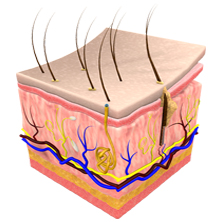Celano R, Piccinelli AL, Pagano I, Roscigno G, Campone L, De Falco E, Russo M, Rastrelli L Food Research International, 2017 ABSTRACT: Distillation wastewaters (DWWs) are generated during the essential oil steam distillation from aromatic herbs. Despite of growing interest on novel source of natural antioxidant compounds as food additives, studies on DWWs are scarse. Herein, the… Read more »

This system includes the skin, hair, sweat glands, and nails. It protects the body against loss of water, abrasion and infection. Common disorders include skin cancer, warts, acne, burns, eczema, vitiligo, and psoriasis.
Essential oil obtained from micropropagated lavender, its effect on HSF cells and application in cosmetic emulsion as a natural protective substance
Andrys D, Adaszyńska-Skwirzyńska M, Kulpa D Natural Product Research, 2017 ABSTRACT: The aim of the study was to determine the influence of the essential oils isolated from the field – grown and micropropagated in vitro narrow – leaved lavender of the ‘Munstead’ cultivar, on human skin cells, and their capability to synthesise procollagen. The amount… Read more »
Chemical composition, antioxidant and antibacterial activities of essential oils from leaves and flowers of Eugenia klotzschiana Berg (Myrtaceae)
Carneiro NS, Alves CCF, Alves JM, Egea MB, Martins CHG, Silva TS, Bretanha LC, Balleste MP, Micke GA, Silveira EV, Miranda MLD Anais da Academia Brasileira de Ciências, 2017 ABSTRACT: Many essential oils (EOs) of different plant species possess interesting antimicrobial effects on buccal bacteria and antioxidant properties. Eugenia klotzschiana Berg (pêra-do-cerrado, in Portuguese) is a species of Myrtaceae with restricted distribution in the Cerrado…. Read more »
Cumin scented leaf essential oil of Cinnamomum chemungianum: compositions and their in vitro antioxidant, α-amylase, α-glucosidase and lipase inhibitory activities
Sriramavaratharajan V, Murugan R Natural Product Research, 2017 ABSTRACT: As part of our work on prospecting of Cinnamomum of the Western Ghats, chemical compositions, antioxidant, α-amylase, α-glucosidase and lipase inhibitory activities of leaf essential oil (EO) of Cinnamomum chemungianum were evaluated. Chemical characterisation of the cumin scented leaf EO from five locations in the southern Western Ghats revealed… Read more »
An in vitro ethnopharmacological study on Prangos ferulacea: a wound healing agent
Yousefi K, Hamedeyazdan S, Hodaei D, Lotfipour F, Baradaran B, Orangi M, Fathiazad F BioImpacts, 2017 ABSTRACT: Introduction: Traditionally Prangos ferulacea root is being used as an effective wound healing agent especially for pus-filled wounds both in human and stocks in the western north of Iran. Regarding the subject we decided to study P. ferulacea roots essential oil (PFE) for its antimicrobial and wound healing activities…. Read more »
Antimicrobial activity of copaiba oil: A review and a call for further research
Tobouti PL, de Andrade Martins TC, Pereira TJ, Mussi MCM Biomedicine & Pharmacotherapy, 2017 ABSTRACT: Copaiba oil has been used for more than 390 years, however, considering the time of empirical use, there are a scarce number of publications on its activities. This essential oil is a phytomedicine proven to be efficient against some microorganisms. However, different from other… Read more »
A comparative study of antibacterial and anti-inflammatory effects of mouthrinse containing tea tree oil
Salvatori C, Barchi L, Guzzo F, Gargari M ORAL & Implantology, 2017 ABSTRACT: The study evaluated the antibacterial and anti-inflammatory efficacy, domiciliary oral hygiene, of a mouthrinse containing Tea Tree Oil (TTO) comparing it with two mouthrinses containing chlorhexidine 0,12% respectively and essential oils, and a placebo. MATERIALS AND METHODS: A pilot study, randomized 4 × 4, controlled, cross-over,… Read more »
Biological, medicinal and toxicological significance of Eucalyptus leaf essential oil: a review
Dhakad AK, Pandey VV, Beg S, Rawat JM Journal of the Science of Food and Agriculture, 2017 ABSTRACT: The genus Eucalyptus L’Heritier comprises about 900 species, of which more than 300 species contain volatile essential oil in their leaves. About 20 species, within these, have a high content of 1,8-cineole (more than 70 %), commercially used for the… Read more »
Interaction of human telomeric G-quadruplex DNA with thymoquinone: a possible mechanism for thymoquinone anticancer effect
Salem AA, El Haty IA, Abdou IM, Mu Y Biochimica et Biophysica Acta, 2015 ABSTRACT: BACKGROUND: Thymoquinone (TQ) has been documented to possess chemo-preventive and chemotherapeutic antitumor effects. Studies reported that TQ inhibits the growth of cancer cells in animal models, culture and xenografted tumors. Molecular mechanisms underlying these anticancer effects were attributed to inductions of cell cycle arrest,… Read more »
Effect of cinnamon (Cinnamomum verum) bark essential oil on the halitosis-associated bacterium Solobacterium moorei and in vitro cytotoxicity
LeBel G, Haas B, Adam AA, Veilleux MP, Lagha AB, Grenier D Archives of Oral Biology, 2017 ABSTRACT: OBJECTIVES: Halitosis, also known as bad breath or oral malodour, is a condition affecting a large proportion of the population. Solobacterium moorei is a Gram-positive anaerobic bacterium that has been specifically associated with halitosis. In this study,… Read more »
